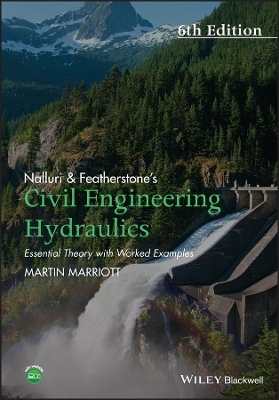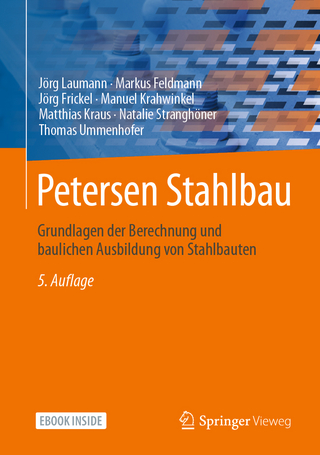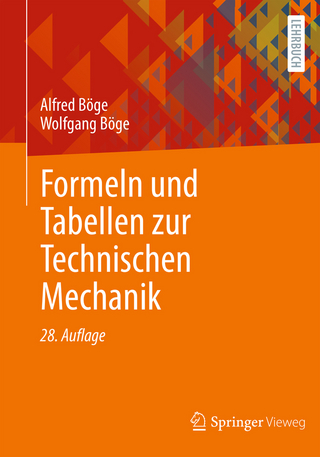
Nalluri And Featherstone's Civil Engineering Hydraulics
Wiley-Blackwell (Verlag)
978-1-118-91563-9 (ISBN)
An update of a classic textbook covering a core subject taught on most civil engineering courses. Civil Engineering Hydraulics, 6th edition contains substantial worked example sections with an online solutions manual. This classic text provides a succinct introduction to the theory of civil engineering hydraulics, together with a large number of worked examples and exercise problems. Each chapter contains theory sections and worked examples, followed by a list of recommended reading and references. There are further problems as a useful resource for students to tackle, and exercises to enable students to assess their understanding. The numerical answers to these are at the back of the book, and solutions are available to download from the book�s companion website.
Martin Marriott is a chartered civil engineer with degrees from the Universities of Cambridge, London (Imperial College) and Hertfordshire. He has wide professional experience in the UK and overseas with major firms of consulting engineers, and many years of experience as a lecturer in higher education. He has an academic management role in the School of Architecture, Computing and Engineering at the University of East London.
Preface to Sixth Edition xi
About the Author xiii
Symbols xv
1 Properties of Fluids 1
1.1 Introduction 1
1.2 Engineering units 1
1.3 Mass density and specific weight 2
1.4 Relative density 2
1.5 Viscosity of fluids 2
1.6 Compressibility and elasticity of fluids 2
1.7 Vapour pressure of liquids 2
1.8 Surface tension and capillarity 3
Worked examples 3
References and recommended reading 5
Problems 5
2 Fluid Statics 7
2.1 Introduction 7
2.2 Pascal’s law 7
2.3 Pressure variation with depth in a static incompressible fluid 8
2.4 Pressure measurement 9
2.5 Hydrostatic thrust on plane surfaces 11
2.6 Pressure diagrams 14
2.7 Hydrostatic thrust on curved surfaces 15
2.8 Hydrostatic buoyant thrust 17
2.9 Stability of floating bodies 17
2.10 Determination of metacentre 18
2.11 Periodic time of rolling (or oscillation) of a floating body 20
2.12 Liquid ballast and the effective metacentric height 20
2.13 Relative equilibrium 22
Worked examples 24
Reference and recommended reading 41
Problems 41
3 Fluid Flow Concepts and Measurements 47
3.1 Kinematics of fluids 47
3.2 Steady and unsteady flows 48
3.3 Uniform and non-uniform flows 48
3.4 Rotational and irrotational flows 49
3.5 One-, two- and three-dimensional flows 49
3.6 Streamtube and continuity equation 49
3.7 Accelerations of fluid particles 50
3.8 Two kinds of fluid flow 51
3.9 Dynamics of fluid flow 52
3.10 Energy equation for an ideal fluid flow 52
3.11 Modified energy equation for real fluid flows 54
3.12 Separation and cavitation in fluid flow 55
3.13 Impulse–momentum equation 56
3.14 Energy losses in sudden transitions 57
3.15 Flow measurement through pipes 58
3.16 Flow measurement through orifices and mouthpieces 60
3.17 Flow measurement in channels 64
Worked examples 69
References and recommended reading 85
Problems 85
4 Flow of Incompressible Fluids in Pipelines 89
4.1 Resistance in circular pipelines flowing full 89
4.2 Resistance to flow in non-circular sections 94
4.3 Local losses 94
Worked examples 95
References and recommended reading 115
Problems 115
5 Pipe Network Analysis 119
5.1 Introduction 119
5.2 The head balance method (‘loop’ method) 120
5.3 The quantity balance method (‘nodal’ method) 121
5.4 The gradient method 123
Worked examples 125
References and recommended reading 142
Problems 143
6 Pump–Pipeline System Analysis and Design 149
6.1 Introduction 149
6.2 Hydraulic gradient in pump–pipeline systems 150
6.3 Multiple pump systems 151
6.4 Variable-speed pump operation 153
6.5 Suction lift limitations 153
Worked examples 154
References and recommended reading 168
Problems 168
7 Boundary Layers on Flat Plates and in Ducts 171
7.1 Introduction 171
7.2 The laminar boundary layer 171
7.3 The turbulent boundary layer 172
7.4 Combined drag due to both laminar and turbulent boundary layers 173
7.5 The displacement thickness 173
7.6 Boundary layers in turbulent pipe flow 174
7.7 The laminar sub-layer 176
Worked examples 178
References and recommended reading 185
Problems 185
8 Steady Flow in Open Channels 187
8.1 Introduction 187
8.2 Uniform flow resistance 188
8.3 Channels of composite roughness 189
8.4 Channels of compound section 190
8.5 Channel design 191
8.6 Uniform flow in part-full circular pipes 194
8.7 Steady, rapidly varied channel flow energy principles 195
8.8 The momentum equation and the hydraulic jump 196
8.9 Steady, gradually varied open channel flow 198
8.10 Computations of gradually varied flow 199
8.11 The direct step method 199
8.12 The standard step method 200
8.13 Canal delivery problems 201
8.14 Culvert flow 202
8.15 Spatially varied flow in open channels 203
Worked examples 205
References and recommended reading 241
Problems 241
9 Dimensional Analysis, Similitude and Hydraulic Models 247
9.1 Introduction 247
9.2 Dimensional analysis 248
9.3 Physical significance of non-dimensional groups 248
9.4 The Buckingham 𝜋 theorem 249
9.5 Similitude and model studies 249
Worked examples 250
References and recommended reading 263
Problems 263
10 Ideal Fluid Flow and Curvilinear Flow 265
10.1 Ideal fluid flow 265
10.2 Streamlines, the stream function 265
10.3 Relationship between discharge and stream function 266
10.4 Circulation and the velocity potential function 267
10.5 Stream functions for basic flow patterns 267
10.6 Combinations of basic flow patterns 269
10.7 Pressure at points in the flow field 269
10.8 The use of flow nets and numerical methods 270
10.9 Curvilinear flow of real fluids 273
10.10 Free and forced vortices 274
Worked examples 274
References and recommended reading 285
Problems 285
11 Gradually Varied Unsteady Flow from Reservoirs 289
11.1 Discharge between reservoirs under varying head 289
11.2 Unsteady flow over a spillway 291
11.3 Flow establishment 292
Worked examples 293
References and recommended reading 302
Problems 302
12 Mass Oscillations and Pressure Transients in Pipelines 305
12.1 Mass oscillation in pipe systems – surge chamber operation 305
12.2 Solution neglecting tunnel friction and throttle losses for sudden discharge stoppage 306
12.3 Solution including tunnel and surge chamber losses for sudden discharge stoppage 307
12.4 Finite difference methods in the solution of the surge chamber equations 308
12.5 Pressure transients in pipelines (waterhammer) 309
12.6 The basic differential equations of waterhammer 311
12.7 Solutions of the waterhammer equations 312
12.8 The Allievi equations 312
12.9 Alternative formulation 315
Worked examples 316
References and recommended reading 322
Problems 322
13 Unsteady Flow in Channels 323
13.1 Introduction 323
13.2 Gradually varied unsteady flow 323
13.3 Surges in open channels 324
13.4 The upstream positive surge 325
13.5 The downstream positive surge 326
13.6 Negative surge waves 327
13.7 The dam break 329
Worked examples 330
References and recommended reading 333
Problems 333
14 Uniform Flow in Loose-Boundary Channels 335
14.1 Introduction 335
14.2 Flow regimes 335
14.3 Incipient (threshold) motion 335
14.4 Resistance to flow in alluvial (loose-bed) channels 337
14.5 Velocity distributions in loose-boundary channels 339
14.6 Sediment transport 339
14.7 Bed load transport 340
14.8 Suspended load transport 343
14.9 Total load transport 345
14.10 Regime channel design 346
14.11 Rigid-bed channels with sediment transport 350
Worked examples 352
References and recommended reading 367
Problems 368
15 Hydraulic Structures 371
15.1 Introduction 371
15.2 Spillways 371
15.3 Energy dissipators and downstream scour protection 376
Worked examples 379
References and recommended reading 389
Problems 390
16 Environmental Hydraulics and Engineering Hydrology 393
16.1 Introduction 393
16.2 Analysis of gauged river flow data 393
16.3 River Thames discharge data 395
16.4 Flood alleviation, sustainability and environmental channels 396
16.5 Project appraisal 397
Worked examples 398
References and recommended reading 405
Problems 406
17 Introduction to Coastal Engineering 409
17.1 Introduction 409
17.2 Waves and wave theories 409
17.3 Wave processes 420
17.4 Wave set-down and set-up 428
17.5 Wave impact, run-up and overtopping 429
17.6 Tides, surges and mean sea level 430
17.7 Tsunami waves 432
Worked examples 433
References and recommended reading 438
Problems 439
Answers 441
Index 447
| Erscheinungsdatum | 10.05.2016 |
|---|---|
| Verlagsort | Hoboken |
| Sprache | englisch |
| Maße | 168 x 241 mm |
| Gewicht | 885 g |
| Themenwelt | Technik ► Bauwesen |
| Technik ► Maschinenbau | |
| ISBN-10 | 1-118-91563-1 / 1118915631 |
| ISBN-13 | 978-1-118-91563-9 / 9781118915639 |
| Zustand | Neuware |
| Informationen gemäß Produktsicherheitsverordnung (GPSR) | |
| Haben Sie eine Frage zum Produkt? |
aus dem Bereich



